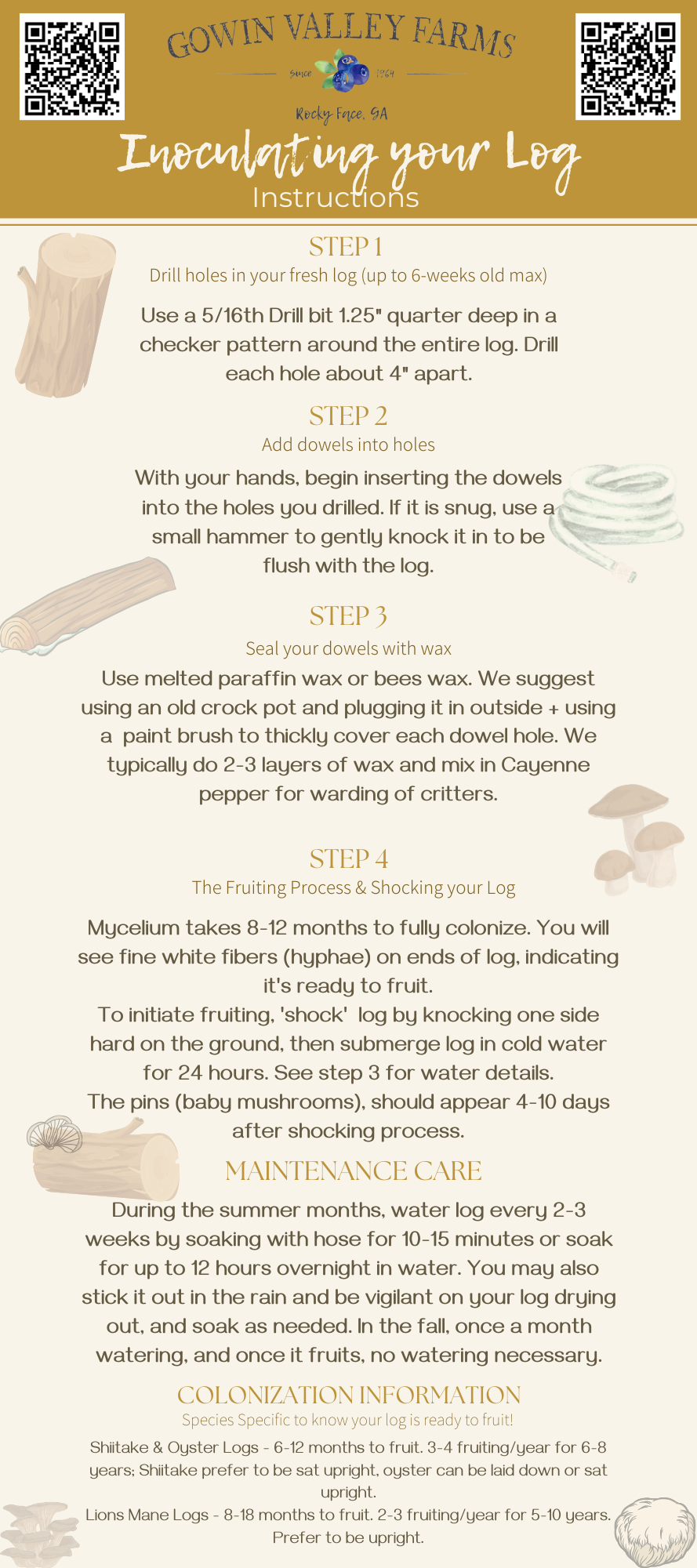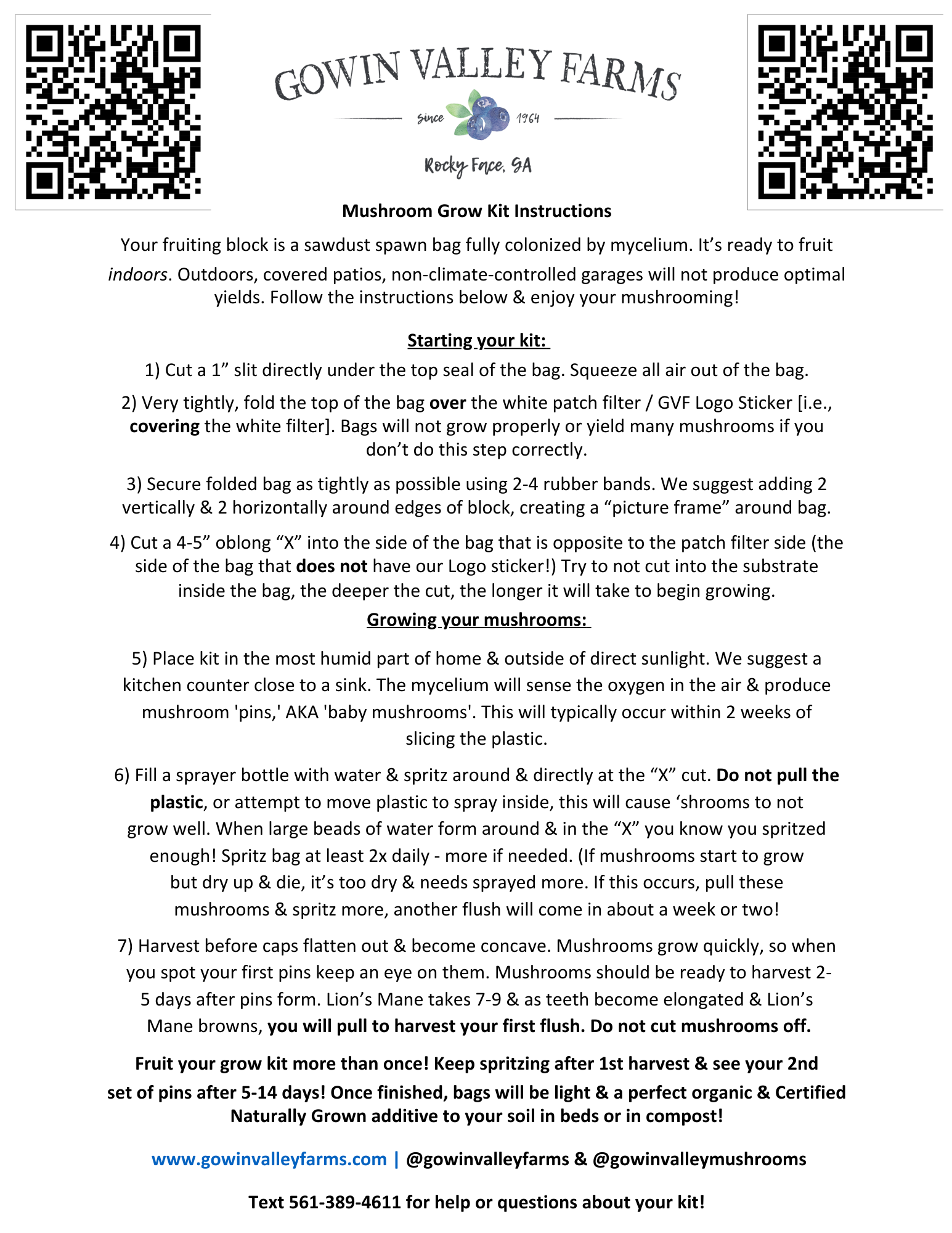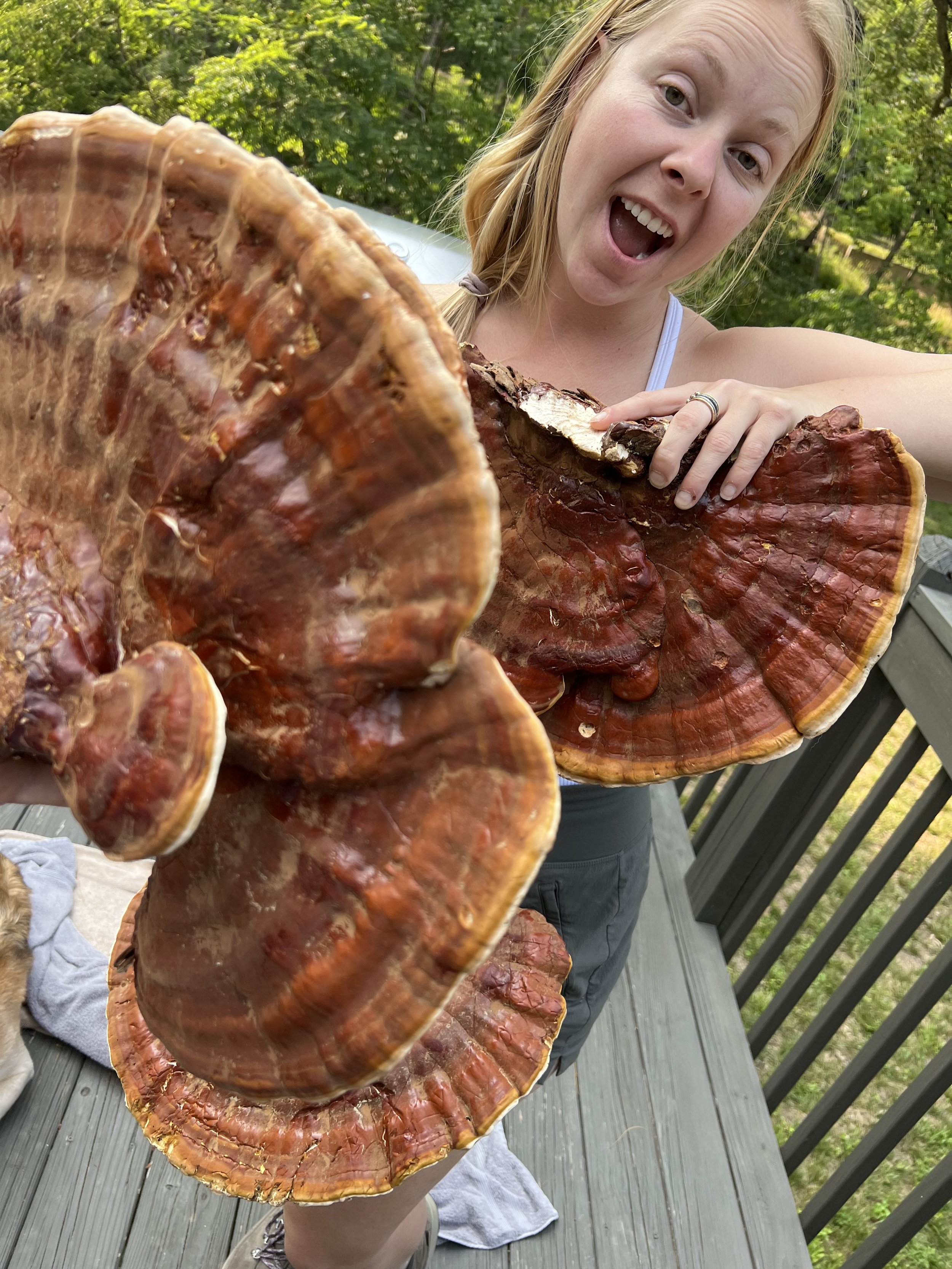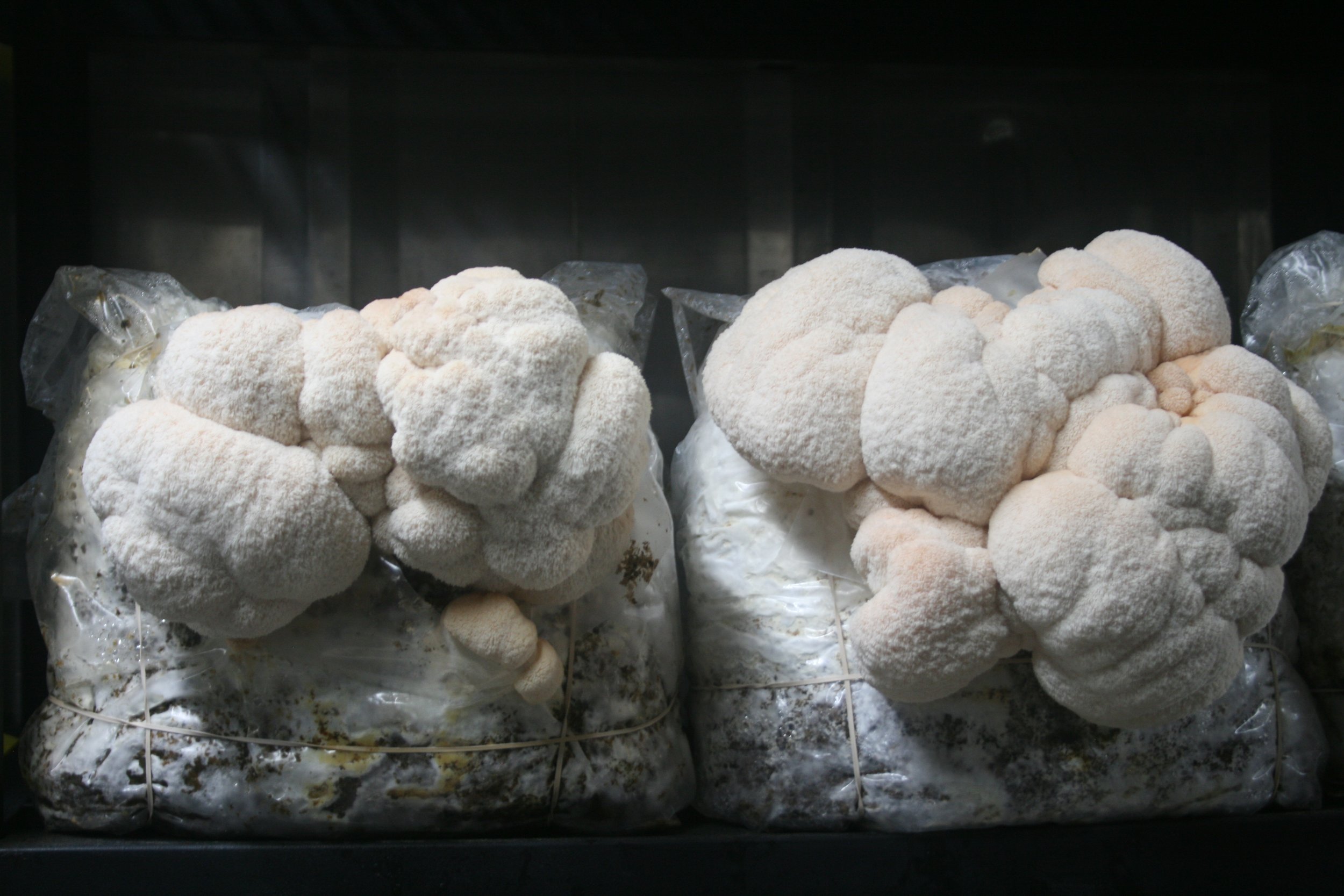Log + Grow Kit Information



FAQ’s
-

How Do I Cook Gowin Valley Farms Mushrooms?
Before using GVF Mushrooms in your recipe at home, we recommend dry sautéing all species of our mushrooms. Meaning no oil or butter in your sauté pan at first until the mushrooms lose some of their water weight and begin turning a light golden-brown color. By dry sautéing, you reduce the rubbery texture + remove any excess water, making them taste and act more like protein. Some wild mushrooms may need to be washed before cooking if they are sandy, but not GVF Mushrooms. Just cut off any excess substrate and voila! Ready to cook.
Let the mushrooms cook for around 4-7 minutes, flipping them once or twice during that process so they cook evenly. Proceed to use them afterward in your recipe. Check our recipes page for inspiration. Enjoy! :)
-

What's the Difference Between Poisonous / Deadly & Non-Edible Mushrooms?
There are several classifications for edibility of wild mushrooms. Poisonous mushrooms have a typical onset of symptoms 30 minutes - 2 hours after ingestion. Typical symptoms may include nausea, stomach cramps, vomiting, diarrhea, headache, dizziness, flushing (warm and red) in the face and abdomen. It is best to immediately seek medical attention after any suspected mushroom poisoning.
Unlike poisonous mushrooms, deadly mushrooms have a symptom onset that begins 6-24 hours after consumption. Symptom onset might include low blood pressure, and similar symptoms as previously described with other poisinous mushrooms.
After 24-36 hours from consuming a deadly mushroom many patients begin to start feeling better and symptoms temporarily dissipate. That is because organ failure in the liver or kidneys has begun taking place. If you have not received medical attention by this time the chances of survival are less than 50%. 48-72 hours after consumption without medical treatment organ failure and death is likely imminent. One single mushroom can contain enough mycotoxins to kill an average-sized adult in some cases even less.
‘Death Caps’ , ‘Destroying Angels’, ‘ or Death Angels’ - are all common names given to Amanita mushrooms (A. bisporigera / A. phalloides) across the world which are the most common deadly mushrooms. Other deadly species in the southeast are called Deadly Galerina (G. marginata and G. autumnalis) which are very common.
Non-edible mushrooms are not deadly, but can occasionally cause GI upset and have an incredibly unpleasant taste. Some people have more adverse reactions than others. It’s is best practice when trying an edible mushroom for the first time to only eat a few bites and to wait 45 minutes to 2 hours before consuming more to make sure you are not allergic.
Never eat a mushroom if you are not 100% certain of the ID as there are many lookalikes of edible mushrooms. Feel free to text us pictures of mushrooms - full photo, cap photo and gills photos for proper ID as we are Wild Mushroom Food Safety Certified. But be sure to note that even the most experienced mycologists with decades of field experience can make mistakes.
And be sure to always remember.
“All mushrooms are edible once.”
-

What are the Health Benefits?
Mushrooms are one of the only vegan sources of Vitamin D. Our mushrooms are low-fat, low-cholesterol, low-calorie and low-carb. Our mushrooms contain high amounts of Iron, B Vitamins, protein, antioxidants and more.
Contrary to claims you might see online no mushrooms have been proven to cure cancer or any other disease in humans or animals. But there have been some recent studies showing promising health benefits with mushrooms in combination with other treatments. Below are some examples:
Neurotrophic properties of Lion's mane
Shiitake as an Integrated Therapeutic Approach
Polysaccharide extract from Grifola frondosa (Maitake mushroom) in breast cancer patients
Ganoderma lucidum (Reishi mushroom) for cancer treatment
Check out our page to learn more about the individual mushroom species’ health benefits we grow and forage.
Misconceptions
-
“Mushrooms Can be Eaten Raw”
As a good rule of thumb, do not eat mushrooms raw. All mushrooms contain a polysaccharide called Chitin which our stomach can’t easily digest, which in some cases can cause GI upset.
Some mushrooms are grown on animal manure by-products or composts which have a higher likelihood for fecal Coliform bacterias such as E.coli. Many restaurants often serve raw Button, Crimini, Portabella or Baby Bella mushrooms on salads which is a prime offender for GI upset.

-
“Gourmet Mushrooms are Hard to Grow”
Nope! Our at-home grow kits make it super easy to grow your own mushrooms right on your countertop at home. Try your hand at a Grow Kit in your kitchen or any climate-controlled area of your home with in-direct light. The only other requirement is a spray bottle of water to mist your mushrooms daily.
These grow kits can also be used to create your own inoculated buckets or logs at home, but we prefer using pre-colonized dowels because of critters like birds, squirrels and otler pests loving to eat the grain in the grow kit bags!

-
"It’s Bad to Touch Poisonous or Non-Edible Fungi”
False! It’s generally safe for any mushroom to be picked up and observed. It’s important to wash or wipe your hands after mushroom hunting to ensure that no cross contaminations occur.
When out looking for mushrooms, you can throw on a pair of gloves if you want to be extra careful or carry some hand sanitizer with you in the field.
It should also be noted to never handle or process any mushrooms that you are uncertain of with other edible species. If collecting for science, poisonous or deadly mushroom should always be kept in a separate container away from mushrooms you intend to eat. Safety first!

-
“Over-Harvesting is not Environmentally Friendly”
False, there is very little to no scientific research pointing to over harvesting wild foraged mushrooms being detrimental to future mushroom growth. The mushroom fruiting body that is visible to the naked eye is just a fraction of the vast mycelial networks which lie beneath the soil or wood.
Similar to picking apples off a tree, when harvested the tree does not die. It’s always best practice to sustainable harvesting and to leave some mushrooms for others to harvest too!
We ask that you be mindful when mushroom hunting, and practices like spore redispersal help promote the future growth of fungi.

